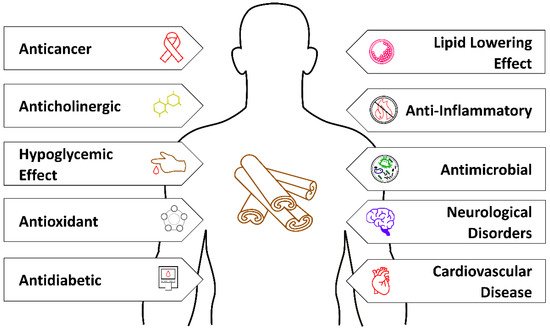1000/1000
Hot
Most Recent

Cinnamon is an unusual tropical plant belonging to the Lauraceae family. It has been used for hundreds of years as a flavor additive, but it has also been used in natural Eastern medicine. Cinnamon extracts are vital oils that contain biologically active compounds, such as cinnamon aldehyde, cinnamic alcohol, cinnamic acid, and cinnamate. It has antioxidant, anti-inflammatory, and antibacterial properties and is used to treat diseases such as diabetes and cardiovascular disease.
| Part | Separation Technique | Sample Preparation | Analysis Method | Determined Compounds * | Ref. |
|---|---|---|---|---|---|
| Leaf | Hydrodistillation | Using a Clevenger-type apparatus. | GCxGC–TOFMS | 4-Hydroxy-4-methyl-2-pentanone, nopinone, p-mentha-1,5-dien-8-ol, verbenone, methyl eugenol, spathulenol, mustakone | Silva et al. [18] |
| Hydrodistillation | Ground cinnamon and submitted to hydrodistillation using a Clevenger-type apparatus. | GC–MS GC–FID |
α-thujene, camphene, sabinene, p-cymene, trans-linalool oxide (furanoid), linalool, borneol, α-terpineol, (E)-cinnamaldehyde, eugenol, (E)-caryophyllene, (E)-cinnamyl acetate, α-humulene, ar-curcumene, γ-gurjunene, caryolan-8-ol, camphor, limonen | Farias et al. [19]; Pragadheesh et al. [20] | |
| Hydrodistillation, supercritical extraction techniques | Small pieces of samples were immersed in distilled water. | GC–MS | Linalool, eugenol | Farias et al. [19]; Jayaprakasha & Jagan Mohan Rao [21] | |
| Maceration extraction | Crushed cinnamon samples were placed in ethanol. | GC–MS | Eugenol, trans-caryophyllene, 1,4,8-cycloundecatriene, glycerol triacetate, 4,6-dimethyldodecane, benzyl benzoate, trans-2-tridecenal, tetradecanamide, oleic acid amide | Khasanah et al. [10] | |
| Fruit | Hydrodistillation | Ground cinnamon and submitted to hydrodistillation using a Clevenger-type apparatus. | GC GC–MS |
Linalool | Kaul et al. [22] |
| Bark | Hydrodistillation | Small pieces of cinnamon bark were immersed in distilled water and extracted using a Clevenger-type apparatus. | GC–FID | Linalool, eugenol, α-pinene, sabinene, α-terpinene, limonene, 1,8-cineole, α-terpinene, terpinolene, terpinen-4-ol, terpineol, methyl eugenol, α-selinene | Abdelwahab et al. [23] |
| Hydrodistillation | Small pieces of cinnamon bark were immersed in distilled water. | GC–MS | Cinnamaldehyde, trans-cinnamyl acetate, coumarin acid, 9-octadecenoic acid, 1,4-benzenedicarboxylic acid, α-pinene, 1,8-cineole, benzaldehyde, γ-terpinene, linalool, camphenilol, borneol, cyclohexane, α-terpinene, eugenol, hydrocinnamic acid, δ-cadinene, propenoic acid, caryophyllene oxide, naphthalenol, hexadecanoic acid, phthalic acid | Kallel et al. [24] | |
| Hydrodistillation | Small pieces of samples were immersed in distilled water. | GC–MS | α-pinene, camphene, β-pinene, p-cymene, limonene, 1,8-cineole, linalool, borneol, 4-terpineol, β-terpineol, bornyl acetate, α-copaene, β-elemene, zingiberene, trans-β-caryophyllene, α-humulene, γ-muurolene, α-guaiene, α-muurolene, δ-cadinene, cadina-1,4-diene, α-calacorene, α-cubebene, δ-cadinol, benzaldehyde, benzylacetaldehyde, cinnamaldehyde, cinnamyl acetate, coumarin | Muhammad et al. [25] | |
| Distillation | Dry ground samples of cinnamon were mixed with distilled water in bottom flask. | GC–MS | Eucalyptol, benzene propanol, trans-cinnamaldehyde, cinnamyl acetate, α-muurolene, coumarin (2H-1-benzopyran-2-one), linalool, eugenol, caryophyllene, eugenyl acetate, benzyl benzoate | Gotmare & Tambe [26] | |
| Steam distillation method | Cinnamon sticks were mashed in smaller pieces and placed in the distillation flask. | HPLC | Cinnamaldehyde | Wong et al. [27] | |
| Supercritical CO2 extraction | Crushed cinnamon was placed in an apparatus. | GC | Cinnamaldehyde, eugenol | Masghati & Ghoreishi [28] | |
| Subcritical extraction | Ground samples of cinnamon were extracted in n-butanol and ethanol. | GC–MS (n-butanol extract) HPLC–MS (ethanol extract) |
N-butanol extract—styrene, benzaldehyde, camphene, β-pinene, linalool, (Z)-cinnamaldehyde, (E)-cinnamaldehyde (main) α-copaene, eugenol, coumarin, methyl cinnamate ethanol extract—procyanidin trimer, catechin, coumarin, (E)-cinnamaldehyde, (Z)-cinnamaledehyde, cinnamyl alcohol |
Liang et al. [29] | |
| Subcritical extraction | Pulverized cinnamon was mixed with distilled water. | HPLC | Coumarin, cinnamic acid, cinnamaldehyde, cinnamyl alcohol | Cha et al. [12] | |
| Soxhlet extraction | Cinnamon sticks were mashed into smaller pieces and placed inside a thimble made from thick filter paper. | HPLC | Cinnamaldehyde | Wong et al. [27] | |
| Water extraction | Crushed samples of cinnamon were dissolved into distilled water after lyophilization. | GC–MS | Cinnamaldehyde, 1,8-cineol, α-terpinolene, borneol, γ-terpinene, benzaldehyde, carvacrol, δ-3-carene | Jin & Cho [30] | |
| Water extraction | Cinnamon dust was immerged in distilled water and heated. | UPLC–MS/MS | Quinic acid, shikimic acid, L-tyrosine, nicotinamide, adenosine, gallic acid, methyl-4-hydroxy-3-methoxycinnamate, protocatechuic acid, protocatechualdehyde, perillene, (+)-catechin hydrate, melittoside, abscisic acid, camphor, coumarin, azelaic acid, isopropyl-4-hydroxybenzoate, 6-gingerol, citric acid, protocatechuic acid, ferulaldehyde, (+)-magnoflorine, curdione, rosavin, abscisic acid, arglabin, L(−)-carnitine | Tang et al. [16] | |
| Sonohydrodistillation | Extraction of essential oil from powdered cinnamon was performed in a sonohydrodistillation unit consisting of a two-neck round-bottom flask. | GC–MS | Cinnamaldehyde | Modi et al. [31] | |
| Ethanol extraction | Plant cinnamon barks were powdered and mixed with ethanol. | LC–MS/MS | Caffeic acid, ferulic acid, pyrogallol, p-hydroxybenzoic acid, vanillin, p-coumaric acid, gallic acid, ascorbic acid | Gulcin et al. [32] | |
| Maceration extraction | Liquid extracts were dried and diluted in ethanol 95%. | RP–HPLC, Folin–Ciocalteu colorimetric method | Cinnamaldehyde, phenols | Othman et al. [13] | |
| Solvent extraction | Cinnamon powder was subjected to different solvents (methanol, ethanol, acetone, water). | UPLC–HRMS | Protocatechuic acid, 3,4-dihydroxybenzaldehyde (protocatechualdehyde), catechin, epicatechin, procyanidin B2, cinnamic acid, quercitrin (quercetin-3-rhamnoside), coumarin, syringic acid, rutin | Muhammad et al. [33] | |
| Pulsed electric field extraction | Ground samples of cinnamon were diluted in ethanol. The mixture was introduced between electrodes. | Folin–Ciocalteu method | Phenols | Pashazadeh et al. [34] | |
| - | Cinnamon powder was applied to the capillary by dipping it in the powder. The capillary was then placed in the helium stream. | DART–MS | Coumarin, cinnamaldehyde, trans-cinnamaldehyde, trans-cinnamic acid, eugenol, benzaldehyde, estragole, linalool, cinnamyl alcohol | Pavlovich et al. [35] |
